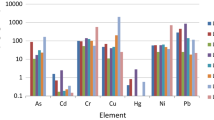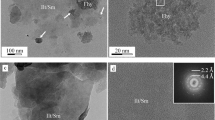Abstract
The processes affecting adsorption of molybdenum (Mo) in alkaline industrial soils are not well known, as most research on Mo fate and transport has focused on agricultural soils. In this work, we performed studies of soil extraction, as well as sorption studies using both batch and stirred-flow cell approaches. After 60 h of extraction, we observed, even where three extractable fractions were present, 14.1 % of the bound residue was extracted by CaCl2 solution. This indicates that the procedures recommended by the Commission of European Communities Bureau of Reference, which is targeted to metals cations, not anions due to the use of extractants at acidic pH, are not a suitable approach for assessing mobility and availability of Mo in alkaline soils. Because the observed extent of Mo adsorption onto two Fe minerals, goethite, and amorphous iron hydroxide (HFO) was 2 to 3 orders of magnitude higher than that onto the soil, soils amended with these Fe minerals were found to have a higher Mo adsorption capacity, with HFO yielding stronger sorption than goethite. The additivity principle was successfully used to predict Mo adsorption with the HFO-amended soil but failed to do so for the goethite-amended soil. The best fit sorption isotherms and estimated parameters were slightly different from batch and flow cell experiments. The K d values of sorption coefficient in our industrial soils and Fe-minerals-amended soils ranged from 0.19 to 1.45 L/kg from both experimental approaches; this low adsorption potential renders it infeasible to immobilize Mo into the soil matrix and reduce Mo availability by amending the soil with Fe minerals. In the future, materials with potentially high Mo adsorption capacities should be identified, screened, and characterized for permeable reactive barriers application.






Similar content being viewed by others
References
Aboul-Kassim, T. A. T., & Simoneit, B. R. T. (2001). Pollutant-solid phase interactions: mechanism, chemistry and modeling. Berlin: Springer.
Bar-Tal, A., Sparks, D. L., Pesek, J. D., & Feigenbaum, S. (1990). Analyses of adsorption-kinetics using a stirred-flow chamber: 1 Theory and critical tests. Soil Science Society of America Journal, 54, 1273–1278.
Bartels, J. M. (1996). Part 3: Chemical methods. In: J. M. Bigham (Ed.), Methods of soil analysis. Madison: Soil Science Society of America, Inc & American Society of Agronomy, Inc., pp. 639–664
Bibak, A. J. P. M., & Borggaard, O. K. (1994). Content and distribution of cobalt, copper, manganese and molybdenum in Danish spodosols and ultisols. Acta Agriculturae Scandinavica Section B Soil and Plant Science, 44(4), 208–213.
Borg, H., Ek, J., & Holm, K. (2001). Influence of acidification and liming on the distribution of trace elements in surface waters. Water, Air, and Soil Pollution, 130, 1757–1762.
Carroll, K. C., Artiola, J. F., & Brusseau, M. L. (2006). Transport of molybdenum in a biosolid-amended alkaline soil. Chemosphere, 65, 778–785.
Cong, Q., Yuan, X., Qu, J., & Zhang, H. W. (2009). The analysis and assessment on the pollution condition of heavy metals in the soil in the farmland around the molybdenum ore areas. Environmental Monitoring in China, 25, 47–51.
Davranche, M., & Bollinger, J. C. (2000). Release of metals from iron oxyhydroxides under reductive conditions: effect of metal/solid interactions. Journal of Colloid and Interface Science, 232, 165–173.
Elliott, H., & Taylor, M. (2000). Molybdenum content of water treatment residuals. Journal of Environmental Quality, 29, 1835–1839.
Geng, C. N., Gao, Y. J., Li, D., Jian, X. P., & Hu. Q. H. (2013). Contamination investigation and risk assessment of molybdenum on an industrial site in China. Journal of Geochemical Exploration (under review).
Goldberg, S., Lesch, S. M., & Suarez, D. L. (2002). Predicting molybdenum adsorption by soils using soil chemical parameters in the constant capacitance model. Soil Science Society of America Journal, 66, 1836–1842.
Goldberg, S., Forster, H. S., & Godfrey, C. L. (1996). Molybdenum adsorption on oxides, clay minerals and soils. Soil Science Society of America Journal, 60, 425–432.
Goldberg, S., Su, C., & Forster, H. S. (1998). Sorption of molybdenum on oxides, clay minerals and soils: mechanisms and models. In E. C. Jenne (Ed.), Adsorption of metals by geomedia: variables, mechanisms and model applications (pp. 401–426). San Diego: Proc. Am. Chem. Soc. Symp. Academic Press.
Gonzalez, B. R., Appeh, H., Schalscha, E. B., & Bingham, F. T. (1974). Molybdate adsorption characteristics of volcanic-ash-derived soils in Chile. Proceedings-Soil Science Society of America, 38, 903–906.
Guo, W., Chen, H., Zhang, Q. Z., & Wang, Y. D. (2011). Effects of biochar application on total nitrogen and alkali-hydrolyzable nitrogen content in the topsoil of the high-yield cropland in north China Plain. Ecology and Environmental Sciences, 20(3), 425–428.
Lemly, A. D. (1994). Agriculture and wildlife: ecological implications of subsurface irrigation drainage. Journal of Arid Environments, 28, 85–94.
Lenoble, V., Bouras, O., Deluchat, V., Serpaud, B., & Bollinger, J. (2002). Arsenic adsorption onto pillared clays and iron oxides. Journal of Colloid and Interface Science, 255, 52–58.
Li, X. L., Li, F. C., Chen, G. Y., Xie, C. R., Wang, J. P., & Li, W. J. (2011). Comparative study on grain-size measured by laser diffraction and sedimentation techniques. Soils, 43(1), 130–134. In Chinese.
Limousin, G., Gaudet, J. P., Charlet, L., Szenknect, S., Barthes, V., & Krimissa, M. (2007). Sorption isotherms: a review on physical bases, modeling and measurement. Applied Geochemistry, 22, 249–275.
Lin, C. X., Chu, C. X., Lu, W. Z., Long, J., Liu, Y., & Xu, S. J. (2004). Chemical characteristics of mangrove soils in the Futian Nature Reserve, Shenzhen. Ecologic Science, 23(2), 118–123 (in Chinese).
Lu, L., & Liu, S. (2011). Determination of chloride content in soil by ion chromatography. Journal of Agriculture, 39–42 (in Chinese).
Lu, R. K. (1999). Analysis method of soil agricultural chemistry. Beijing: China Agricultural Science and Technology.
Manning, B. A., & Goldberg, S. (1996). Modeling arsenate competitive adsorption on kaolinite, montmorillonite and illite. Clays and Clay Minerals, 44, 609–623.
MEP (Ministry of Environmental Protection). (1990). Soil elements background in China. Beijing: Chinese Environmental Science.
O’Connor, G. A., Brobst, R. B., Chaney, R. L., Kincaid, R. L., McDowell, L. R., Pierzynski, G. M., et al. (2001). A modified risk assessment to establish molybdenum standards for land application of biosolids. Journal of Environmental Quality, 30, 1490–1507.
Zhang, P. C., & Sparks, D. L. (1989). Kinetics and mechanisms of molybdate adsorption/desorption at the goethite/water interface using pressure-jump relaxation. Soil Science Society of America Journal, 53, 1028–1034.
Qu, J., Yuan, X., Wang, L. L., & Wang, N. (2007). Analysis and assessment on the pollution condition of heavy metals in the soil of molybdenum mine. Environmental Protection Science, 33(36–38), 48.
Selim, H. M., & Amacher, M. C. (1997). Reactivity and transport of heavy metals in soils. Boca Raton: CRC.
Seyfried, M. S., Sparks, D. L., Bartal, A., & Feigenbaum, S. (1989). Kinetics of calcium magnesium exchange on soil using a stirredflow reaction chamber. Soil Science Society of America Journal, 53, 406–410.
SBQTS (Shandong Bureau of Quality and Technical Supervision). (2010). Determination of chloride ion content in soil—ion chromatography method. Shandong, China: DB37/T 1555–2010 (in Chinese).
Yang, S. F., Lin, C. F., Lin Angela, Y. C., & Hong Andy, P. K. (2011). Sorption and biodegradation of sulfonamide antibiotics by activated sludge: experimental assessment using batch data obtained under aerobic conditions. Water Research, 45, 3389–3397.
Sjöstedt, S., Wällstedt, T., Gustafsson, J. P., & Borg, H. (2009). Speciation of aluminum, arsenic and molybdenum in excessively limed lakes. Science of the Total Environment, 407, 5119–5127.
Smith, P., Smith, J. U., Powlson, D. S., McGill, W. B., Arah, J. R. M., Chertov, O. G., et al. (1997). A comparison of the performance of nine soil organic matter models using datasets from seven long-term experiments. Geoderma, 81, 153–225.
Sposito, G. (1985). Chemical models of inorganic pollutants in soils. CRC Critical Reviews in Environmental Control, 15, 1–24.
Theng, B. K. G. (1971). Adsorption of molybdate by some crystalline and amorphous soil clays. New Zealand Journal of Science, 14, 1040–1056.
Jiang, W., Zhang, S. Z., Shan, X. Q., Feng, M. H., Zhu, Y. G., & McLaren, R. G. (2005). Adsorption of arsenate on soils. Part 1: Laboratory batch experiments using 16 Chinese soils with different physiochemical properties. Environmental Pollution, 138, 278–284.
Xie, R. J., & MacKenzie, A. F. (1991). Molybdate sorption–desorption in soils treated with phosphate. Geoderma, 48, 321–333.
Xie, R. J., MacKenzie, A. F., & Lou, Z. J. (1993). Causal modelling of pH and phosphate effects on molybdate sorption in three temperate soils. Soil Science, 155(6), 385–397.
Žemberyová, M., Hagarová, I., Zimová, J., Barteková, J., & Kuss, H. M. (2010). Determination of molybdenum in extracts of soil and sewage sludge CRMs after fractionation by means of BCR modified sequential extraction procedure. Talanta, 82, 582–586.
Zhang, M. K. (2004). Evaluation of phosphorus leachability in sand soils by means of soil P test. Actapedologica Sinica, 41(6), 996–1000 (in Chinese).
Zhang, Y., Lashermes, G., Houot, S., Doublet, J., Steyer, J. P., Zhu, Y. G., et al. (2012). Modelling of organic matter dynamic during the composting process. Waste Management, 32, 19–30.
Acknowledgments
The authors would like to thank the Natural Science Foundation of China (grant no. 21107072), State Key Laboratory of Soil and Sustainable Agriculture (Institute of Soil Science, Chinese Academy of Sciences, grant no.Y052010026), China Postdoctoral Science Foundation (grant no. 2012 M520408), and Ministry of Environmental Protection of China (grant no. 201109052) for the financial support of this work.
Author information
Authors and Affiliations
Corresponding author
Rights and permissions
About this article
Cite this article
Geng, C., Jian, X., Su, Y. et al. Assessing Molybdenum Adsorption onto an Industrial Soil and Iron Minerals. Water Air Soil Pollut 224, 1743 (2013). https://doi.org/10.1007/s11270-013-1743-6
Received:
Accepted:
Published:
DOI: https://doi.org/10.1007/s11270-013-1743-6




